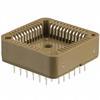Physical input devices serve as a tactile interface between users and computing systems. These devices are often complex assemblies that consist of both electrical and mechanical components making customization difficult and out of reach for non-engineers. While these components can now be 3D printed on demand, they must still be independently designed and assembled. We present FlexKeys, an approach in which devices that include both electrical and deformable components can be created in a single print on a multi-material 3D printer, requiring no assembly. Designers can customize devices including the input type, travel distance and layout of keys, textures of surfaces, and route all electrical signals directly to a microcontroller socket. In many instances, these devices require no support material, producing a functional device the moment a print finishes. We demonstrate this approach by creating a customized keyboard and report on validation measurements of individual input keys as well as highlighting additional designs. This work provides the first step towards lowering the barrier to entry for non-engineers to design custom tactile inputs, enabling occupational and physical therapists, clinicians, and educators to design and create devices directly based on their assessments of individual user needs.
翻译:物理输入装置是用户和计算系统之间的触觉界面。 这些装置通常是复杂的组件, 由电气和机械部件组成, 使得非发动机难以定制, 无法直接接触这些部件。 虽然这些部件现在可以按需要打印 3D, 但仍必须独立设计和组装。 我们展示了FlexKeys, 这是一种方法, 可以在多材料 3D 打印机上以单一打印方式创建包含电气和变形部件的装置, 不需要组装。 设计者可以定制设备, 包括键、 表面纹理的输入类型、 旅行距离和布局, 以及将所有电子信号直接传送到微控制器套。 在许多情况下, 这些装置不需要任何支持材料, 在打印完成时刻产生功能装置。 我们通过创建定制键盘和报告单个输入键的验证测量结果以及突出额外设计, 来展示这一方法。 这项工作为降低非工程师在设计自定义触动输入、 使职业和物理治疗师、 临床医生和教育家能够直接根据个人用户需求的评估设计和创建装置的进入障碍提供了第一步。




